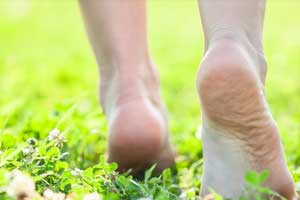- Home
- Editorial
- News
- Practice Guidelines
- Anesthesiology Guidelines
- Cancer Guidelines
- Cardiac Sciences Guidelines
- Critical Care Guidelines
- Dentistry Guidelines
- Dermatology Guidelines
- Diabetes and Endo Guidelines
- Diagnostics Guidelines
- ENT Guidelines
- Featured Practice Guidelines
- Gastroenterology Guidelines
- Geriatrics Guidelines
- Medicine Guidelines
- Nephrology Guidelines
- Neurosciences Guidelines
- Obs and Gynae Guidelines
- Ophthalmology Guidelines
- Orthopaedics Guidelines
- Paediatrics Guidelines
- Psychiatry Guidelines
- Pulmonology Guidelines
- Radiology Guidelines
- Surgery Guidelines
- Urology Guidelines
Footwear habits may influence child motor skill development

Different motor skills are developed in children and adolescents who spend most of their time barefoot from those who habitually wear shoes, according to a study published in the journal Frontiers of Pediatrics.
The study is first of its to assess the relevance of growing up shod vs. barefoot on jumping, balancing and sprinting motor performance during different stages of childhood and adolescence. According to the findings of the study habitual barefoot children are better at jumping and balancing compared to habitually shod children, particularly from 6-10 years of age. However beneficial barefoot effects decreased in older adolescents.
Professor Astrid Zech, the lead author of the study told that walking barefoot is widely thought to be more natural, and the use of footwear has long been discussed as an influencing factor on foot health and movement pattern development.
She said, "A few studies report that barefoot situations change biomechanics in children and adults during running and jumping -- but only limited knowledge exists for the clinical relevance of this finding. "We wanted to investigate, for the first time, whether changes in foot biomechanics due to barefoot activities are actually relevant for the development of basic motor skills during childhood and adolescence," she added.
Zech and her associates assessed three motor skills- balance, standing long jump and a-20 m sprint in 810 children and adolescents from 22 primary and secondary schools. The study participants were divided into two groups having two different lifestyles. One group consisted of children from South Africa who were habitually barefoot while the other group consisted of children who belonged to Germany and wore shoes most of the time.
The study found that habitually barefoot participants scored significantly higher in the balance and jumping tests compared to the habitually shod participants. This difference was observed in both test conditions (barefoot and shod) and across all age groups (6-10, 11-14 and 15-18 years), but specifically more prominent in 6-10-year-old children. The habitually barefoot children also performed better when barefoot than when shod.
On the contrary, the results of the sprint test were different. In the sprint test, the habitually shod children performed better, particularly those in the 11-14 year age group and both the groups performed better while shod.
The researchers gave a probable explanation suggesting that environment may have influenced this result as it could not be standardized across the two study locations.
"In South Africa, the sprint test took place outdoors - with different weather conditions and surfaces. In contrast, the German children took the sprint test indoors, mostly in a sports hall with a sprung floor," says Zech. "The type of shoe may also have influenced the results. South African students run in school shoes, while German students use sneakers or athletic shoes in their physical education classes. So while our results suggest that growing up shod may be beneficial for fast sprinting, we need to investigate this further."
"Physical education classes, exercise and sports programs, and reactional activities that aim to improve basic motor skills could benefit from including barefoot activities," says Zech. "Parents could also encourage regular barefoot time at home."
The study concluded that the barefoot physical activities for motor development are more beneficial than shod and emphasized the importance of footwear habits for the development of motor skills during childhood and adolescence.
For reference log on to https://doi.org/10.3389/fped.2018.00115

Disclaimer: This site is primarily intended for healthcare professionals. Any content/information on this website does not replace the advice of medical and/or health professionals and should not be construed as medical/diagnostic advice/endorsement or prescription. Use of this site is subject to our terms of use, privacy policy, advertisement policy. © 2020 Minerva Medical Treatment Pvt Ltd